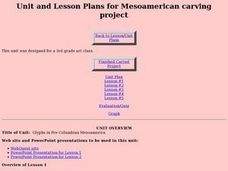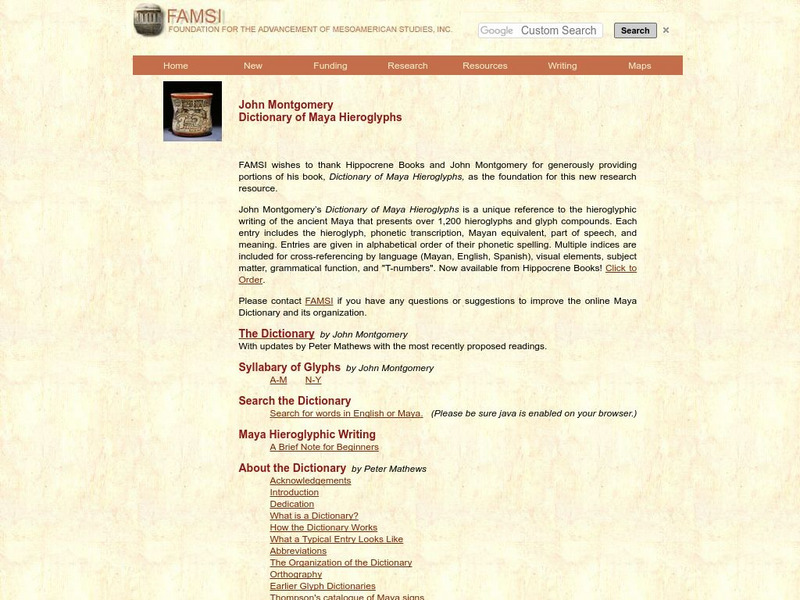Curated OER
The Mayan Empire
Students study vocabulary associated with the Mayan Empire; its art, daily life, inventions, and religious beliefs. They examine why the Mayan culture is considered to be one of the most advanced of the ancient civilizations by...
Curated OER
Central American Immigrants to the United States: Refugees from Unrest
Students identify the major aspects of Olmec and Mayan civilzations, including economic, political, and religious. They list contributions of these civilizations. Students identify the Central American countries where the United States...
Curated OER
Come On Over To Maya Place
Fifth graders analyze the Mayan culture. In this Mayan culture lesson plan, 5th graders study the Mayan culture noting similarities and differences between the Mayan culture and their own. Students examine hieroglyphic writing and the...
Curated OER
Who Were the Mayans?
In this Mayans worksheet, learners read about the Mayans on a web site given, then complete a set of 10 related comprehension questions.
Curated OER
Old Mayan Mural
Students read a story called Scientists Discover Oldest Mayan Mural and answer vocabulary and comprehension questions about it. In this current events Mayan mural lesson plan, students respond to literature by answering questions,...
Penn Museum
Ancient History Math Mystery
Through several organized and attractive worksheets, your learners will make a deduction about tally marks and hieroglyphics to determine what they represent in the ancient numeral system. This is a well-designed, interdisciplinary...
Curated OER
Me Oh Maya
Students compare basketball to Mayan ring-ball. They write a newspaper article that may have been published during Mayan times.
Curated OER
Ofelia Romero The Maya Culture and Civilization
Fifth graders investigate the Mayan culture, number system, alphabet, hieroglyphics, history, civilization, artistry, and sports in this series of lessons.
Curated OER
Mesoamerican Carving Project
Third graders are introduced to the use of glyphs and relief carving by Mesoamerican cultures. They complete worksheets, view PowerPoint presentations, participate in a Webquest and create an original glyph carving in sandstone.
Core Knowledge Foundation
Maya, Aztec, and Inca Civilizations
A 10-lesson unit explores the Maya, Aztec, and Inca civilizations. Over the course of two weeks, scholars read nonfiction excerpts, discuss their findings, and complete activities. An assessment equipped with multiple choice and matching...
Curated OER
Sport as Social Ritual
Students become familiar with the sport that became a social ritual in ancient American cultures, examining its importance. They gain an understanding of how contemporary sports have acquired importance within modern American culture.
Foundation for the Advancement of Mesoamerican Studies
Famsi: Primary Standard Sequence (Of Mayan Hieroglyphs) 2003
PDF document that shows structure of Mayan glyphs and translation, including spelling patterns and syntax. Photographs and charts show how meaning is derived from hieroglyphic strip.
Foundation for the Advancement of Mesoamerican Studies
Famsi: Dictionary of Maya Hieroglyphs
John Montgomery's Dictionary of Maya Hieroglyphs is a unique reference to the hieroglyphic writing of the ancient Maya that presents over 1,200 hieroglyphs or glyph compounds. Each entry includes the hieroglyph, phonetic transcription,...
Foundation for the Advancement of Mesoamerican Studies
Famsi: Salvage of Hieroglyphic Stairway in Dos Pilas (2002)
Comprehensive discussion of what the discovery of stairway steps adds to history of the site and the culture. Writings on steps give new insights to Myan politics, trade, war, and the collapse of the civilization.
Foundation for the Advancement of Mesoamerican Studies
Famsi: Southern Belize Epigraphic Project: Hieroglyphic
Report of a 13 year study of the least documented hieroglyphic of the Mayan culture in Belize and their possible meanings. Site can be viewed in English and Spanish.
Foundation for the Advancement of Mesoamerican Studies
Famsi: The Glyphic Corpus From Ek' Balam (2002)
Offers translations of hieroglyphs, and therefore history, of the Mayan dynasties and rulers at Ek' Balum in Yucatan, Mexico.
Foundation for the Advancement of Mesoamerican Studies
Famsi: Recording New Inscription of Palenque (1995)
Research reports includes an enormous amount of photographs and drawings of stucco hieroglyphs from various temples.
Foundation for the Advancement of Mesoamerican Studies
Famsi: Investigation and Conservation at San Bartolo (2002)
Excavation reveals murals in tunnels and earliest example of painted hieroglyphic script in Maya Lowlands.
Other
Early Maya Writing at San Bartolo, Guatemala (2006)
Click to download full PDF article documenting that Mayan writing system was already in place in 100 B.C. Move cursor over trowels to navigate this site.
Foundation for the Advancement of Mesoamerican Studies
Famsi: Identifying Individual Hands in (Palenque) Monuments
Study attempts to identify individual artists who created temple hieroglyphs and questions why some monuments indicate more artists at work than others.
BBC
Bbc: Excavations and Techniques: Naachtun: A Lost City of the Maya
An Indiana Jones type of adventure. Imagine a lost city deep in the jungles! Site provides information on the Mayan city of Naachtun and the culture of the Mayan.
The History Cat
The History Cat: Cracking the Mayan Code
Discusses the Maya system of hieroglyphic writing. It was viewed by Spanish invaders as the work of the devil and most of the written materials were destroyed under the orders of a Spanish priest whose goal was to convert the Mayans to...
PBS
Pbs Nova: Reading Maya Hieroglyphs
Part of a larger site from PBS on Mayan culture, this page refers specifically to the Mayan form of writing through hieroglyphs.
Foundation for the Advancement of Mesoamerican Studies
Famsi: The Jolja' Cave Project (2001)
Three caves containing pre-Columbian artifacts, murals, and hieroglyphs are documented in this report. Also of interest is commentary on the reports of modern Ch'ol Mayans with regard to ancient belief and current religious belief.























